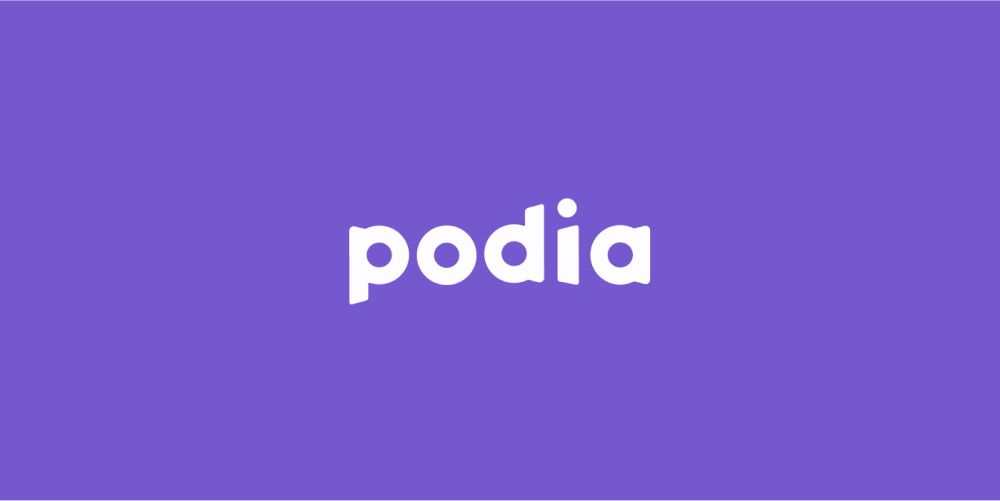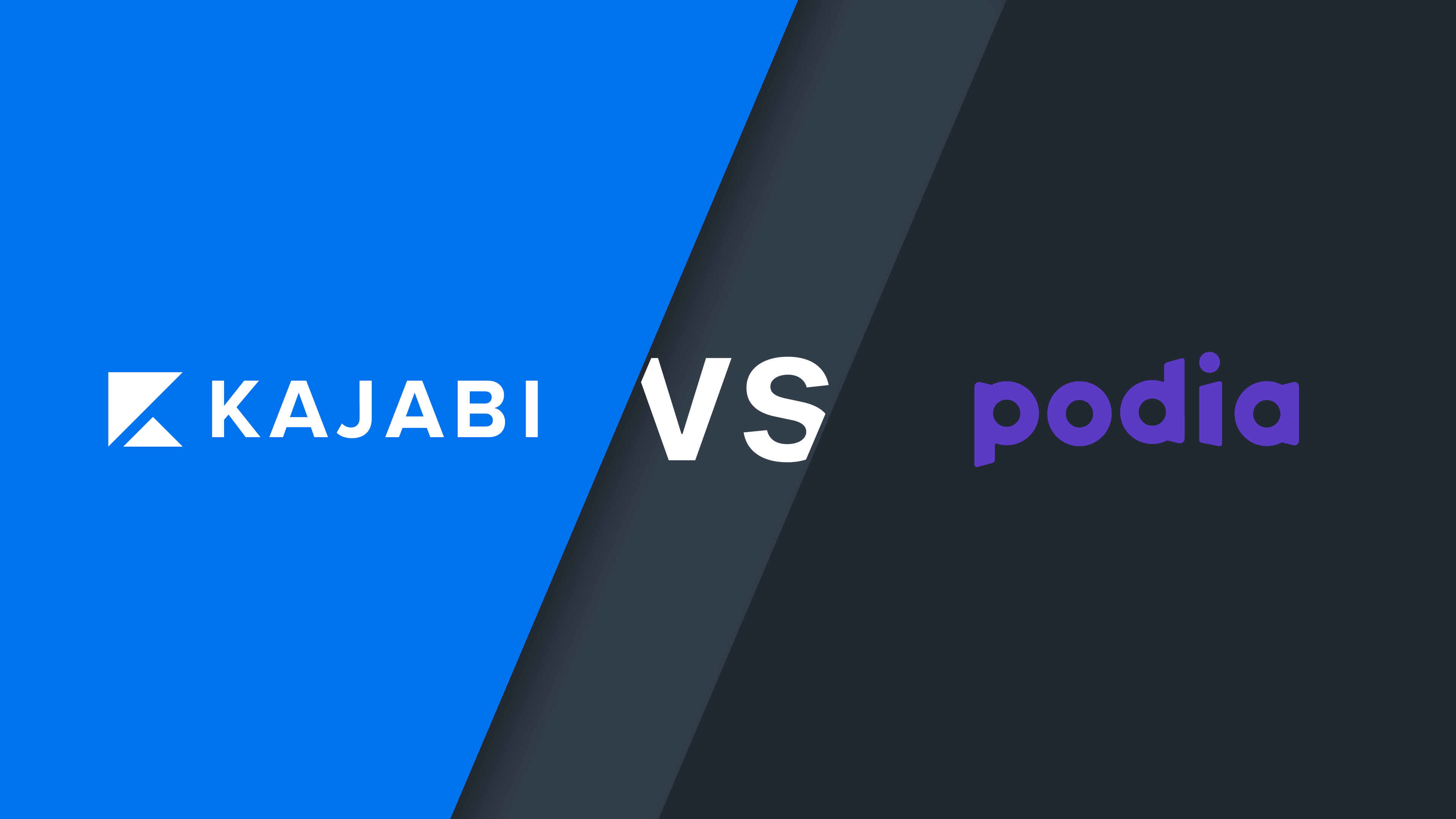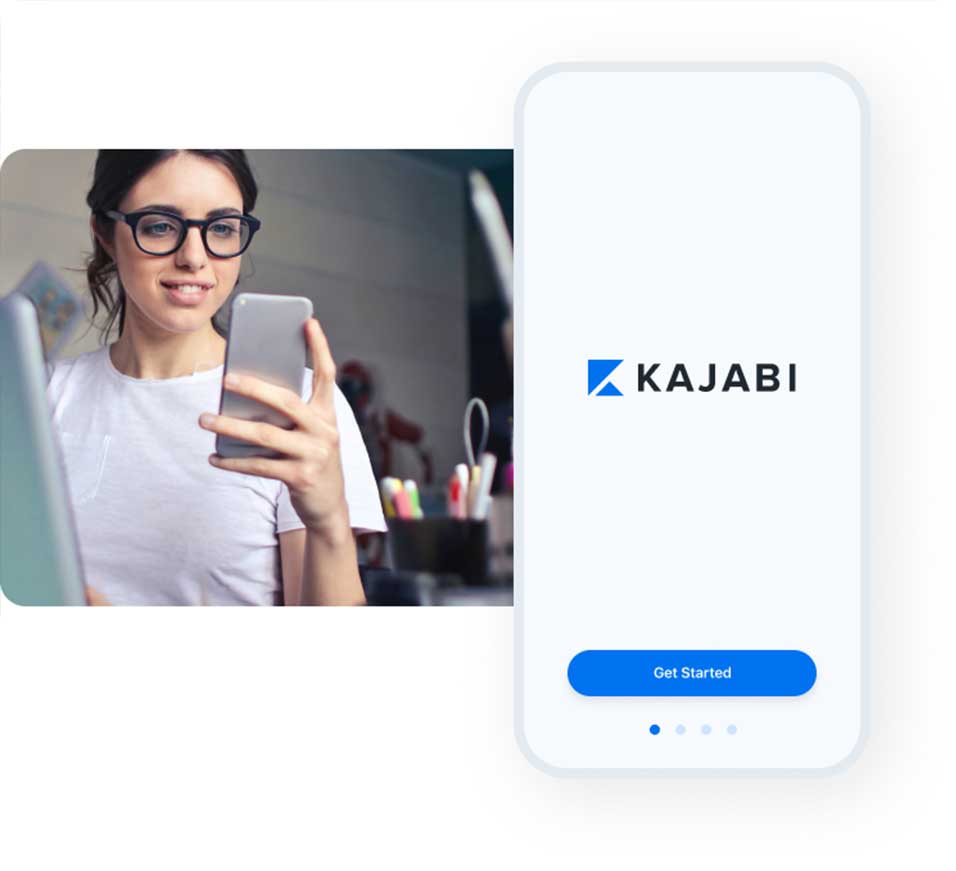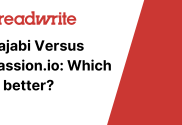Kajabi Versus Podia: Which is Better?
In today’s rapidly growing digital landscape, online course creators, educators, and entrepreneurs are in constant search of reliable, user-friendly, and affordable platforms to build, market, and sell their courses. Amidst a plethora of options available in the market, Kajabi and Podia have emerged as two of the leading online course platforms, catering to a wide range of professionals seeking to cultivate their eLearning ventures.
|
Featured Partner 
on Kajabi’s website
|
In this article, we will delve into a comprehensive comparison of Kajabi and Podia, evaluating their features, functionality, pricing, and overall suitability for different users’ needs.
Join us as we guide you through the crucial elements of these two popular platforms in an attempt to help you decide which one best aligns with your vision for a successful online course business.
What is Kajabi
Kajabi is an all-in-one platform that makes it easy to create, market, and sell online courses and membership sites. It provides content creators and business owners with tools for building websites, designing marketing campaigns, and managing payments.

Kajabi simplifies the process of building an online business and helps users grow their audience, scale their content, and sell more effectively.
What is Podia
Podia is an online platform that allows creators, entrepreneurs, and educators to host, sell, and deliver various types of digital products and services, such as online courses, membership subscriptions, and digital downloads.

It provides users with tools for marketing, sales, and customer engagement. Podia aims to simplify the process of selling online by providing an all-in-one solution for content creators.
Why Use?
Kajabi and Podia are both online platforms that allow users to create, market, and sell online courses, digital products, and membership sites. They provide various features and tools to assist in building and managing the online presence of content creators, educators, and influencers.
Here are different example use-cases for Kajabi and Podia:
1. Online Courses:
Kajabi: A fitness expert can create a series of workout courses, complete with video lessons, downloadable resources, and quizzes to track progress. They can use Kajabi’s course builder to organize the content, set up payment systems, and engage with students.
Podia: A language teacher can build a comprehensive curriculum for learning a foreign language. They can use Podia to host video lessons, audio files, and written documents. Customers can enroll in and access the course materials from the platform.
2. Membership Sites:
Kajabi: A business consultant can offer exclusive content, workshops, and live Q&A sessions for a monthly subscription fee. Kajabi allows them to create a membership site where they can drip-feed content, organize materials by categories, and interact with members in community forums.
Podia: A financial expert can create a members-only platform providing subscribers with access to exclusive market analysis, video content, live webinars, and premium articles. Podia provides the tools to manage the content for different membership tiers and handle billing.
3. Digital Products:
Kajabi: An author can sell e-books, audiobooks, or PDF guides through Kajabi’s digital product capabilities. They can set up a sales page, integrate payment options, and allow customers to download the product after purchase.
Podia: A graphic designer can sell digital assets like templates, fonts, or stock photos on Podia. They can create a storefront to showcase their products, manage product delivery, and handle customer transactions.
4. Webinars and Online Events:
Kajabi: A motivational speaker can use Kajabi to organize and host live webinars or pre-recorded video series, enabling them to share their expertise with a broader audience. They can create landing pages for event registration, integrate with marketing tools, and collect leads.
Podia: A software company can use Podia to provide customers with live product demos, launch events, and interactive Q&A sessions. They can use Podia’s webinar features to schedule events, communicate with attendees, and share recordings.
5. Coaching and Consulting Services:
Kajabi: A career coach can offer their services through Kajabi by creating a designated coaching package with multiple sessions, booking features, and follow-up materials. Clients can schedule appointments and access resources within the platform.
Podia: A marketing consultant can sell one-on-one consultations, group coaching sessions, or courses designed for specific business sectors. Podia allows them to create service packages, manage bookings, and communicate with clients.
In summary, both Kajabi and Podia serve as versatile platforms for individuals and businesses looking to create and sell online courses, digital products, and memberships. They provide the necessary tools for building and managing these offerings, including content hosting, marketing, and payment processing.
|
Featured Partner 
on Kajabi’s website
|
Features
Kajabi:
Kajabi is an all-in-one online platform that offers businesses and individuals a comprehensive toolkit for creating, selling, and marketing digital products and online courses. Kajabi’s main features are designed to empower creators in different aspects of their online course creation journey.

Course Creation:
- Kajabi allows users to design their unique online courses with various customization options, such as themes, templates, and media uploads. Creators can easily organize their course content, develop quizzes or assessments, and create automated course progress tracking to enhance the learning experience for their students.
Website Building and Hosting:
- Kajabi provides a user-friendly website builder with customizable templates, themes, and unlimited landing pages, helping creators build clean, modern websites for their courses. Integrated e-commerce and course management features streamline the process of selling courses, offering creators a seamless experience.
Marketing:
- Kajabi’s marketing tools are tailored for online businesses, giving creators access to email marketing, CRM, and automation tools, enabling them to create targeted marketing campaigns, manage customer relationships, and track performance metrics. Social media integration allows for seamless promotion of courses across different platforms.
Sales Funnels:
- Kajabi’s built-in sales funnel tools (referred to as Pipelines) enable creators to customize and manage their sales funnels to optimize conversions across different marketing channels.
Integrations and Analytics:
- Kajabi offers a wide range of integrations with third-party applications, including payment gateways, email marketing tools, and customer relationship management systems. Detailed analytics help creators to monitor performance metrics, including engagement, sales, and customer behavior.
Podia:
Podia is an all-in-one platform designed to help creators sell digital products, online courses, and memberships. The platform’s main features cater to individuals looking to create and sell digital content seamlessly.
Course Creation:
- Podia provides an easy-to-use interface for creating, organizing, and publishing online courses, including videos, documents, and other resources. Creators can drip content over time, create student discussions, and offer quizzes to enhance the learning experience.
Digital Products and Memberships:
- Podia allows users to sell a wide range of digital products, such as eBooks, templates, checklists, and more. In addition, users can set up membership sites, offering subscribers access to exclusive content, community interactions, and tier-based pricing.
Website Builder:
- Podia features a fully customizable website builder with pre-built templates and elements, offering creators the ability to personalize the look and feel of their website. Websites are mobile-responsive and optimized for search engines, ensuring maximum visibility.
Email Marketing:
- Podia’s built-in email marketing allows creators to manage their email lists, segment subscribers, create automated campaigns, and track performance, all within the platform. Combined with membership management, this feature helps creators engage and nurture their audience over time.
Sales and Integrations:
- Podia offers a streamlined sales process with a simple checkout experience and supports various payment options, including PayPal and Stripe. The platform also integrates with popular third-party tools, enhancing the overall functionality and giving creators flexibility in managing their businesses.
Customer Support:
- Podia prides itself on offering exceptional customer support with a dedicated team ready to help creators navigate the platform and troubleshoot any issues during their course-creation journey.
|
Featured Partner 
on Kajabi’s website
|
Pros n Cons
Kajabi Pros:
1. All-in-one platform: Kajabi offers a comprehensive suite of tools that include website building, course creation, marketing, and sales integration, making it convenient for users.
2. Robust course building features: Kajabi offers various course building options, allowing for versatile content delivery, including video, text, quizzes, and downloads.
3. Customization and branding: Kajabi offers a high level of customization for creating and branding your course, allowing for a unique look and feel.
4. Email marketing and automation: Kajabi has built-in email marketing tools and automation to help you seamlessly engage with your audience and boost sales.
5. Strong analytics: The platform provides easy access to detailed analytics, helping you track course performance and make data-driven decisions.
6. Community and support: Kajabi has a robust online community and offers exceptional customer support.
Kajabi Cons:
1. Price: Kajabi can be quite expensive, especially for beginners or those with a limited budget.
2. Learning curve: Kajabi has a lot of features, which can be overwhelming for new users, resulting in a steep learning curve.
3. Limited external integration: While Kajabi offers many essential integrations, it may lack some specific integrations desired by users.
Podia Pros:
1. Ease of use: Podia is known for its user-friendly interface and simplicity of navigation, making it a great option for beginners or those looking for a more straightforward experience.
2. All-in-one platform: Like Kajabi, Podia offers a comprehensive suite of tools, including course creation, website building, email marketing, and sales integration.
3. No transaction fees: Podia does not charge any transaction fees on sales, increasing profitability for course creators.
4. Unlimited courses and students: Podia offers unlimited courses and student enrollment, allowing you to grow without worrying about hitting limits.
5. Affiliate marketing: Podia has an integrated affiliate marketing system, enabling you to leverage influencers and increase your course sales.
Podia Cons:
1. Limited customization: Podia has fewer customization options compared to Kajabi, which may be a drawback for users wanting a more unique course appearance.
2. No built-in course assessments: Unlike Kajabi, Podia does not offer built-in quizzes or assessment tools, which can limit the course interactivity and learning experience.
3. No native live streaming: Podia does not provide live streaming functionality within the platform, so you’ll need to rely on external tools like Zoom or YouTube for live streaming.
4. Limited email automation: Podia’s email automation features aren’t as robust as Kajabi’s, offering fewer options for creating customized email sequences.
5. Pricing: Although more affordable than Kajabi, Podia’s pricing may still be a concern for some users, particularly those on a tight budget.
|
Featured Partner 
on Kajabi’s website
|
How to setup Kajabi
Step 1: Sign up for a Kajabi account
- Visit Kajab’s website at https://www.kajabi.com/.
- Click on the “Get Started” or “Start Free Trial” button.
- Fill out the required information, including your name, email address, and password.
- Click “Create your Kajabi account” to complete the registration process.
Step 2: Choose a plan
- Review Kajabi’s pricing options to determine which plan best suits your needs.
- Select a plan, which can be changed at any time, by clicking on the “Choose Plan” button below your preferred option.
- Fill out your payment details to activate the plan.
Step 3: Customize your site
- Log in to your Kajabi dashboard.
- Click “Website” in the left-hand menu and then “Design Your Site.”
- Choose a theme for your site and adjust colors, fonts, and other visual elements to match your brand.
- Create and customize pages (such as Home, About, Contact, etc.) by clicking “Pages” in the left-hand menu, and then “Add New Page.”
Step 4: Create online courses or products
- Click “Products” in the left-hand menu of your dashboard.
- Click “Create a new product” and choose a product template (such as mini-course, online course, or community).
- Provide a name and description for your product and click on “Create a Product.”
- Customize your product’s content by adding sections, lectures, and other materials.
- Configure your product’s settings, including pricing, access rules, and integrations with other tools.
Step 5: Set up payment and marketing options
- Click “Settings” in the left-hand menu and then “Payments” to connect Kajabi to your preferred payment gateway (e.g., Stripe, PayPal).
- Customize your checkout settings, such as currency, taxes, and legal agreements.
- Set up email marketing, if desired, by clicking “Email” in the left-hand menu and connecting Kajabi to an email service provider such as Mailchimp or ActiveCampaign.
- Create and customize marketing funnels, also known as pipelines, to automate your sales process by clicking “Pipelines” in the left-hand menu and then “Create New Pipeline.”
After completing the steps above, your Kajabi site will be ready to launch. Share the link to your site with your audience, promote your courses, and watch your online business grow!
|
Featured Partner 
on Kajabi’s website
|
How to setup Podia
Setting up a Podia account is a simple process that will enable you to build and host your online platform to sell digital products or courses.
Follow these step-by-step instructions to get started:
1. Visit the Podia website:
- Start by navigating to the Podia website (https://www.podia.com/) using your web browser.
2. Sign up for an account:
- On the homepage, click the “Get started for free” button in the middle of the page or at the top right corner.
- You will be redirected to the signup page.
- Enter your name, email, and password, and click the “Create your free account” button. Alternatively, you can sign up using your Google or Facebook account.
3. Choose your workspace type:
- After signing up, you will be prompted to select the type of workspace you want to create – a Membership site, Digital Downloads, or Online Courses. Select the option that best suits your needs. You can always add other types of content later.
4. Customize your storefront:
- Upon selecting your workspace type, you will be taken to the dashboard, where you can customize the appearance of your storefront. Click “Customize” on the left side menu to change your site’s logo, colors, font, and other elements.
- Additionally, you can add a custom domain name instead of using the default Podia subdomain.
5. Create your first product:
- Click “Products” on the left side menu to begin creating your first digital product, course, or membership.
- Select the type of content you want to create (course, digital download, or membership) and enter the basic details, such as title, price, and a brief description.
- Once you have set up the basic structure, you can start adding content, such as videos, audios, text, PDFs, or quizzes.
6. Set up payment methods:
- To process payments from your customers, you need to connect your Podia account with a payment provider. Go to “Settings” on the left side menu and then click “Payment providers” to connect your Stripe or PayPal account by following the on-screen instructions.
7. Launch your storefront:
- After customizing your site, creating your content, and connecting your payment provider, you are ready to launch your Podia storefront. Go to “Dashboard” and click the “Set up your Store” button. Once completed, your store will be live and accessible to customers.
8. Promote your products:
- Share your products and courses with your target audience via social media, email marketing, or your personal website. Podia also offers built-in marketing tools, such as email campaigns, to help you reach potential customers.
- Keep exploring Podia’s features and integrations to further optimize your online presence and increase sales. Good luck with your new Podia storefront!
|
Featured Partner 
on Kajabi’s website
|
Main Differences
Kajabi and Podia are both popular online platforms that allow users to create, manage, and sell online courses, digital products, and memberships. They offer a range of tools designed to streamline content creation, marketing, and sales, empowering entrepreneurs and educators to grow their businesses.

Kajabi is often hailed for its extensive suite of features and customizations, which come pre-built into the platform, requiring minimal technical skills to deploy. Offering robust marketing tools, automated email campaigns, pipelines (visual sales funnels), and comprehensive analytics, Kajabi caters to those seeking a one-stop shop for managing and scaling their online businesses.
On the other hand, Podia’s platform prides itself on simplicity and ease of use. With its intuitive interface, Podia is well-suited for beginners or those looking for a straightforward solution to host their courses and products without the need for advanced marketing capabilities.
When it comes to pricing, Podia’s plans are generally more affordable, starting at $39 per month for the basic “Mover” plan and offering unlimited courses, digital downloads, and students. Kajabi, on the other hand, starts at $149 per month for its “Basic” plan and places limits on the number of products and active members.
Ultimately, the choice between Kajabi and Podia depends on your specific needs, budget, and preferences. If you’re searching for a comprehensive all-in-one solution with extensive customization options, Kajabi may be the right fit, but if affordability and an easy-to-use interface are your priorities, Podia is worth considering.
Pricing Comparison
Kajabi and Podia are both online platforms that allow users to create, market, and sell online courses, memberships, and digital products. They offer different pricing plans to suit the needs of various users.
Here is a comparison of their pricing plans:
Kajabi’s Pricing Plans:
- Basic Plan:
- $149 per month (billed annually) or $199 per month (billed monthly)
- 3 products and 3 pipelines
- 1,000 active members
- 1 website and 1 admin user
- 0% transaction fees
- Unlimited landing pages and marketing emails
- Webinars and events, chat support, and more
- Growth Plan:
- $199 per month (billed annually) or $299 per month (billed monthly)
- 15 products and 15 pipelines
- 10,000 active members
- 1 website and up to 10 admin users
- 0% transaction fees
- Unlimited landing pages and marketing emails
- Advanced features like 24/7 chat support, automated webinars, and more
- Pro Plan
- $399 per month (billed annually) or $499 per month (billed monthly)
- 100 products and 100 pipelines
- 20,000 active members
- 1 website and up to 25 admin users
- 0% transaction fees
- Unlimited landing pages and marketing emails
- Premium features like 24/7 phone support, affiliate program, and more
Sign Up
Podia Pricing Plan’s:
- Mover Plan:
- $39 per month (billed annually) or $49 per month (billed monthly)
- Unlimited courses and digital products
- Unlimited customers
- Unlimited email subscribers
- Unlimited video bandwidth
- Custom domain
- Shaker Plan:
- $79 per month (billed annually) or $99 per month (billed monthly)
- Memberships
- Embedded checkout
- Affiliate marketing
- Third-party code
- Live chat support
- Offsite buy buttons
- Additional payment processor (PayPal)
In summary, Kajabi offers more tiered plans with additional features and flexibility, but their pricing starts at a higher rate compared to Podia. Podia, on the other hand, has fewer pricing plans but provides unlimited courses, digital products, and customers even at the lower-priced Mover plan. Your choice would largely depend on your specific needs, goals, and budget.
|
Featured Partner 
on Kajabi’s website
|
Frequently Asked Questions
Q: What are the key differences between Kajabi and Podia?
A: Kajabi focuses on offering a more comprehensive all-in-one platform with features such as advanced marketing tools, course authoring, and built-in email marketing, making it more suitable for larger businesses or those with more complex needs. On the other hand, Podia is a simpler platform that is easy to use for beginners and smaller-scale entrepreneurs, offering basic features for creating courses and digital products.
Q: What pricing options do Kajabi and Podia offer?
A: Kajabi offers three pricing plans: Basic ($149/month), Growth ($199/month), and Pro ($399/month). Each plan comes with a different set of features and capabilities, catering to varying business sizes and needs. Podia has two pricing plans: Mover ($39/month) and Shaker ($79/month). Both plans offer unlimited access to all features, with the Shaker plan including additional perks like memberships, embedded checkout, and affiliate marketing.
Q: Are there free trials available for both platforms?
A: Yes, both Kajabi and Podia offer a free trial for users to test their platforms before committing. Kajabi offers a 14-day free trial, while Podia provides a 14-day free trial as well.
Q:Which platform is better for beginners?
A: Podia is generally considered more beginner-friendly due to its simple interface and easy-to-navigate design. Users with little to no experience in creating online courses and digital products may find Podia more accessible and straightforward to use.
Q: Can I use my own domain with Kajabi and Podia?
A: Yes, both Kajabi and Podia allow you to connect your own custom domain to your online courses and digital product storefronts, giving your business a professional appearance.
Q: What kind of customer support is available on Kajabi and Podia?
A: Kajabi offers customer support through various channels, including live chat, email, and phone support for Pro plan users. They also provide a comprehensive knowledge base and community forum. Podia’s customer support is available through live chat and email, with a helpful knowledge base to support users in finding answers to their questions.
Q: Can I create membership sites on both platforms?
A: Yes, both Kajabi and Podia offer the ability to create membership sites. Kajabi provides a more advanced membership setup with various levels and access controls, while Podia offers a simpler approach suitable for small-scale businesses.
Q: Do Kajabi and Podia have built-in email marketing tools?
A: Kajabi has a built-in email marketing tool that allows users to create, send, and track email campaigns. Podia, on the other hand, offers basic email communication and integration with third-party email marketing services like MailChimp and ConvertKit.
|
Featured Partner 
on Kajabi’s website
|
Conclusion
In conclusion, both Kajabi and Podia offer robust and versatile platforms for digital creators and online entrepreneurs to build, market, and sell online courses, memberships, and digital products. While Kajabi caters to a wide range of digital businesses and provides extensive marketing capabilities, Podia focuses on ease of use and affordability for solopreneurs and small businesses.
Ultimately, the choice between Kajabi and Podia will depend on individual needs, budget, and personal preferences. By carefully considering the features, pricing, and customer support offered by both platforms, aspiring course creators can make an informed decision to select the platform that best fits their unique business goals and requirements.
In this dynamic digital landscape, it is essential to choose the right partner to succeed on the journey of empowering and educating your target audience with quality content.







